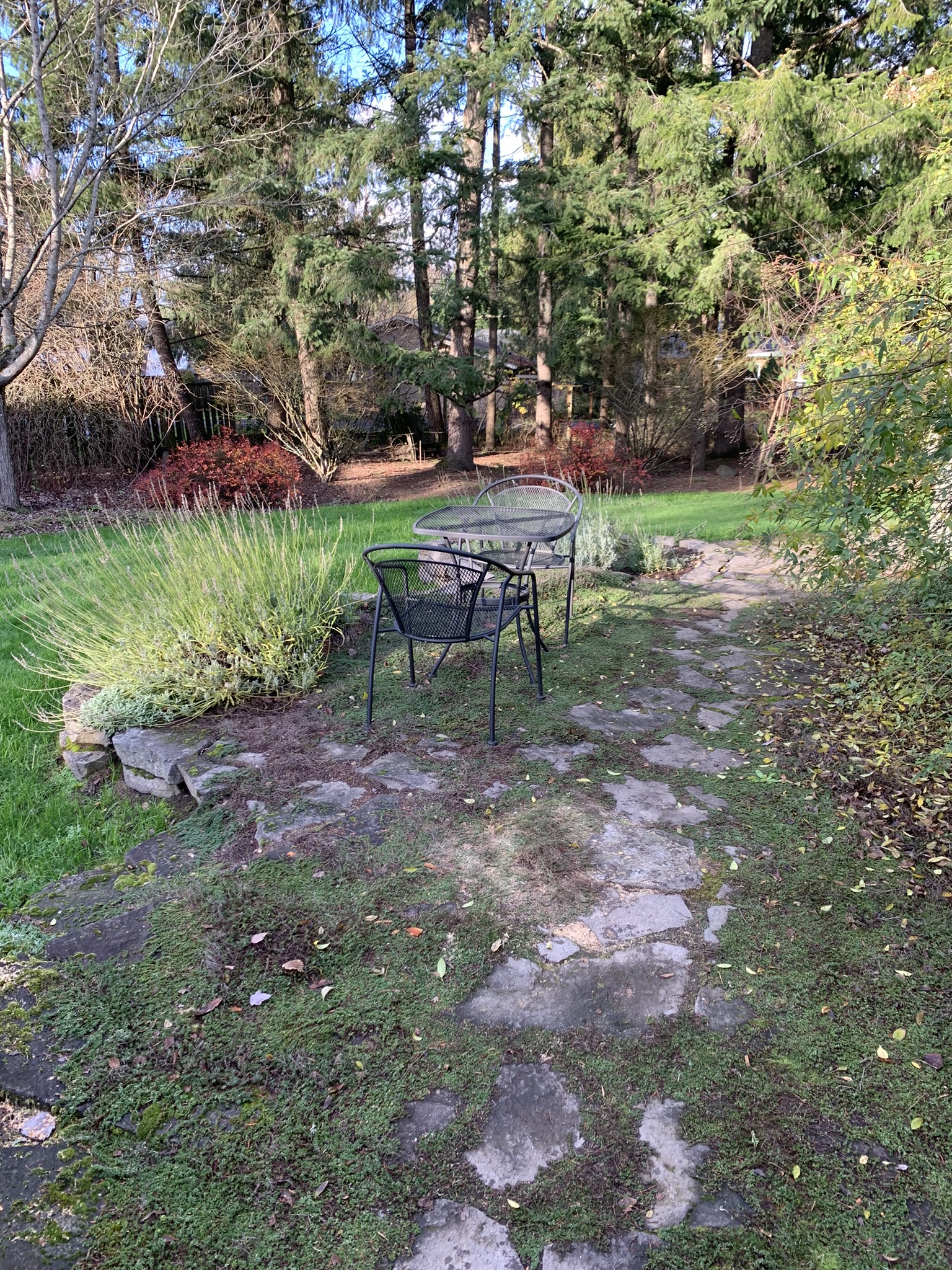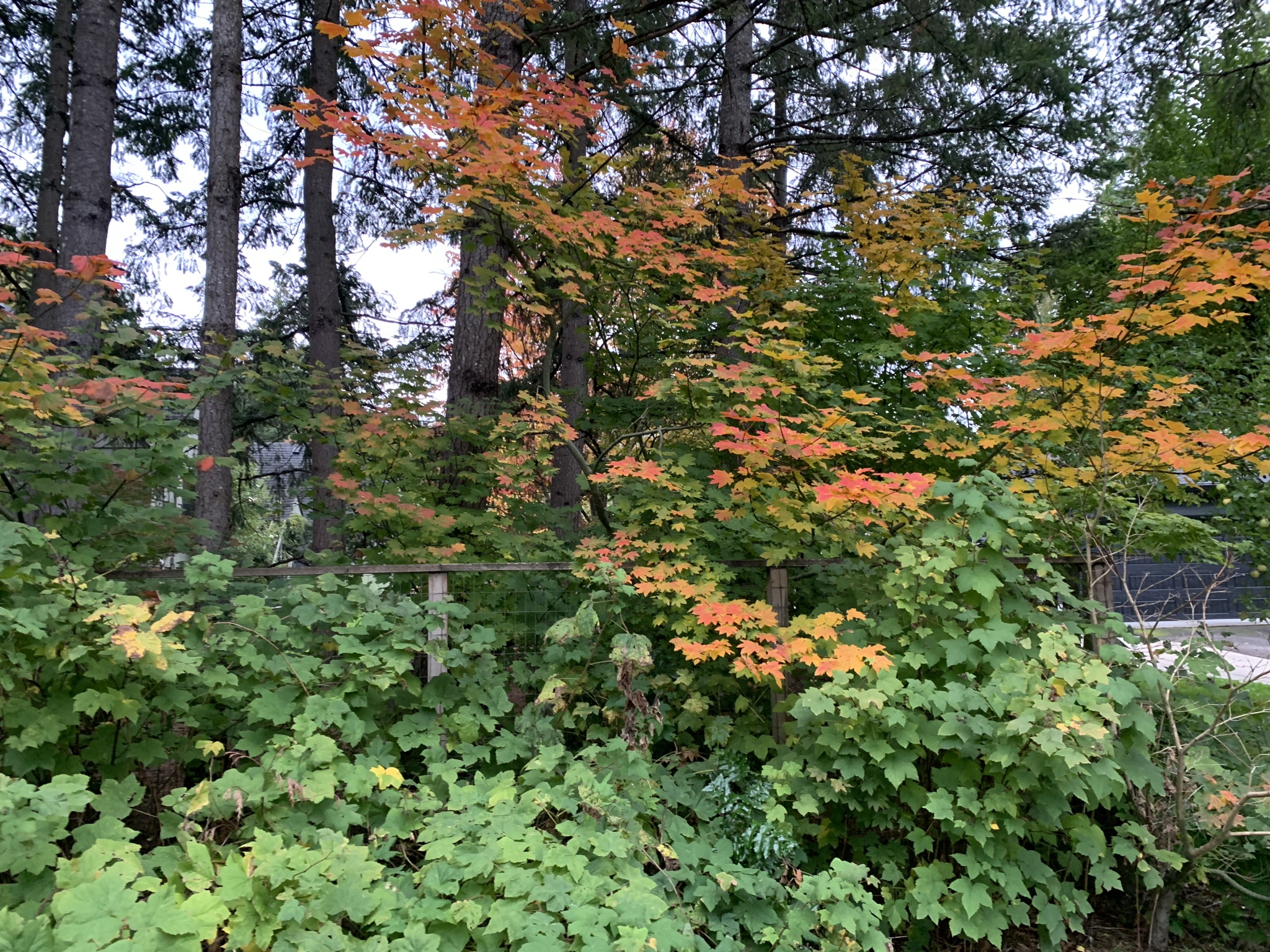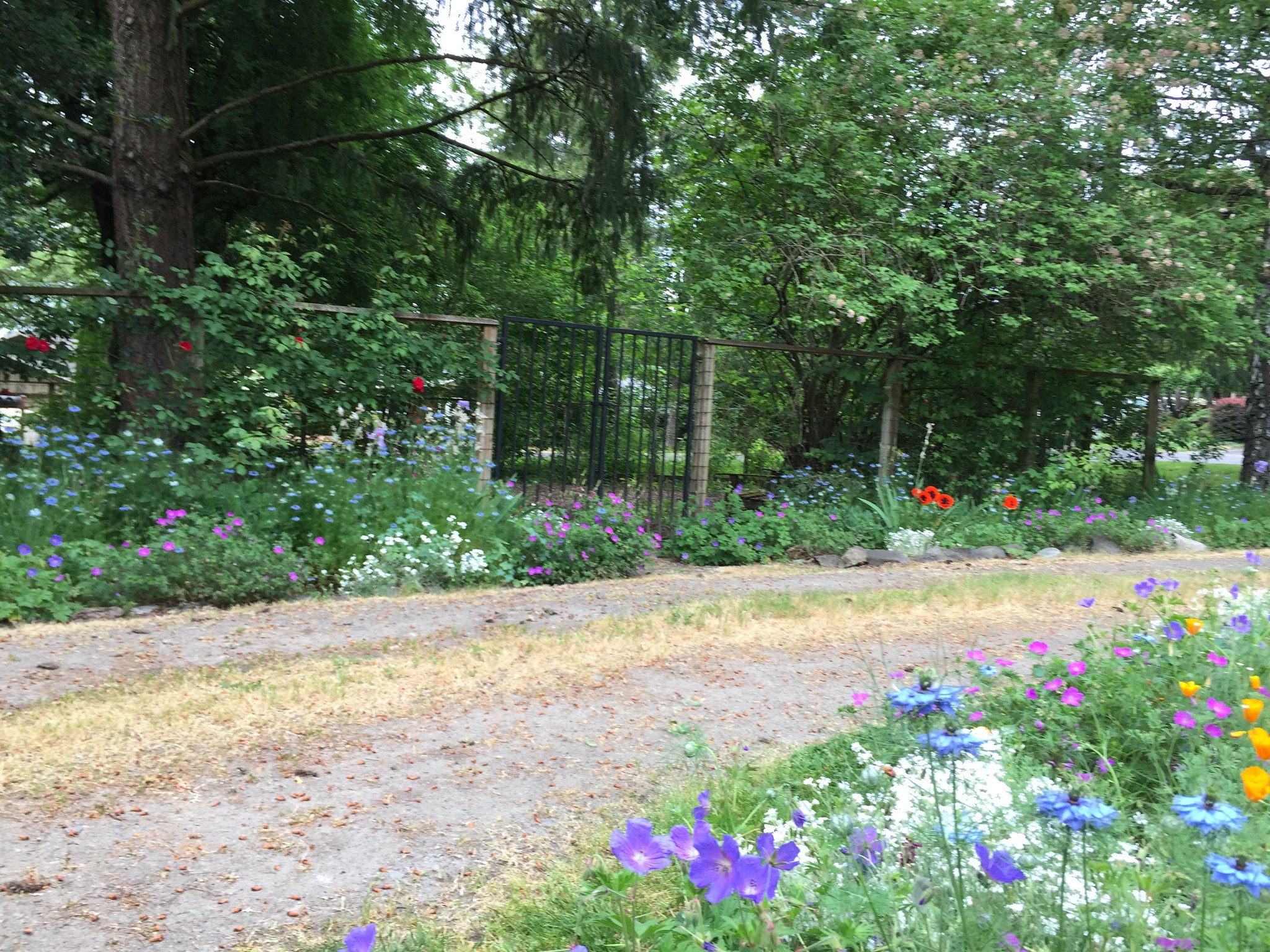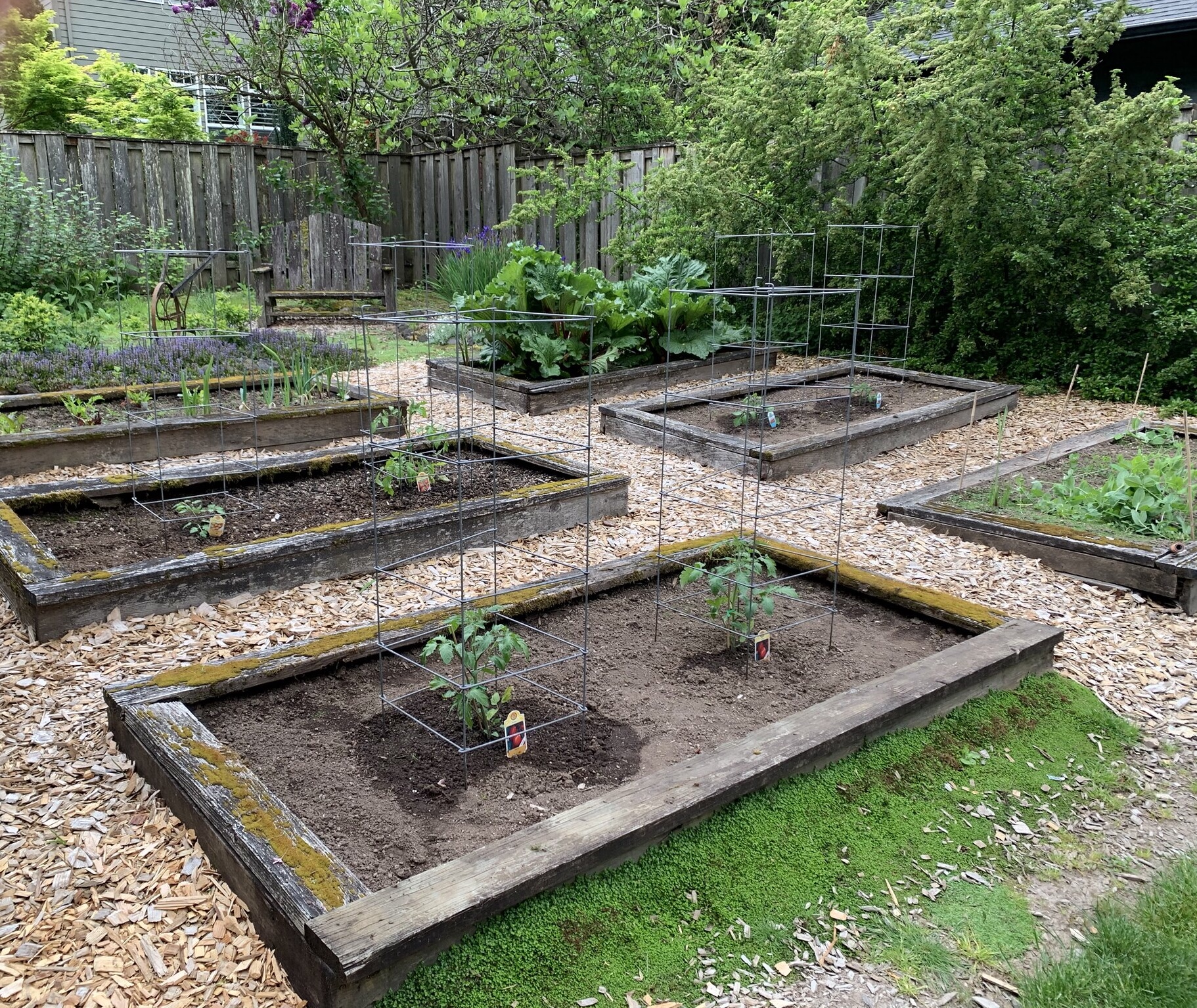Site Information: Anne and Gary’s habitat in Garden Home in Washington County is part to full sun to full shade, with dry to moist soil conditions and a slope

What inspired you to enroll in the Backyard Habitat Certification Program?
Our property was once part of a cedar/fir forest inhabited by the Atfalati-Kalapuya people. Many cedars and fir remain in the area, but our property was cleared for a family farm in the 1920s. We didn’t start out to bring back the native habitat or be certified as such, but slowly and surely over 40 years that’s exactly what has happened!
In the early 1980s, my husband planted our very large side yard with Douglas fir seedlings. The inspiration was an article we saw in Sunset magazine about planting a forest (not necessarily a native one) in your backyard! As the seedlings matured, we added vine maple and planted more Douglas fir along the stormwater drainage swale abutting our property. After we added birdbaths, we were certified as a Wildlife Habitat by the National Wildlife Federation.
With the trees taller and the grass gone, native plants began reappearing on their own. The little grove of firs became Gary’s favorite part of the yard. After his sudden death in 2014, the area was christened Gary’s Forest and brings me much solace.
Major stormwater issues in 2017 led me to a partnership with Clean Water Services to remove invasive yellow flag iris and add native plants to the swales. I also worked with the contractor, Native Plantscapes NW, to add more understory natives to Gary’s Forest.
Then in 2020 the neighbors and I began collaborating with the Urban Conservation Program of the Tualatin Soil and Water Conservation District. Our project will add more natives to the under-planted parts of the swales and replace invasive holly with pollinator shrubs.
District staff suggested Backyard Habitat Certification as an important adjunct to the project. Forty years of work paid off, and our property was certified at the platinum level!
How would you describe your habitat?
Our 3/8 acre corner property in Garden Home is on a gentle north-facing slope draining toward Fanno Creek. The very large side yard contains a mature Douglas fir canopy with understory plants including vine maple, osoberry, thimbleberry, ocean spray, Oregon grape, and sword ferns. Native plants which have returned on their own include snowberry, western hazelnut, stream violets, blue-eyed grass, and fireweed.
Many of the same plants edge the swale along the narrow side street just to the north of the fir grove. The swale is planted with juncus to help slow storm water flow. It has developed its own course giving it the appearance of a small creek. The plantings improve neighborhood aesthetics and giving a sense of (riparian!) place for the many neighbors who walk by.
The front of our property is sunny and open. It features a perennial cottage garden developed over many years to blend with our English cottage home. While mostly non-native, the flowers require no water and attract many pollinators. No pesticides are used and the original permeable-surface driveway remains.
A stormwater swale planted with juncus, camas, Oregon iris, and blue-eyed grass runs along the street in the front. The swale plantings help treat storm water by filtering and soaking up sediment and pollutants.
Our main backyard is also sunny and open. The remaining lawn is neither watered nor fertilized. The backyard includes an organic raised bed kitchen garden, sitting areas with pollinator-attracting catmint and lavender, and a mixture of cottage garden and native flowering shrubs along the fence lines. Most stunning are the red flowering currant where juncos flit about!

What are your top three favorite native plants and why do you love them?
- Douglas fir – What’s not to love about majestic firs grown from seedlings your husband planted as a young man.
- Snowberry – The arrival of this shrub as a volunteer was exciting because I had loved the pearly berries on the snowberry we had in our yard when I was a child.
- Baldhip rose and camas – My mother and father each remembered and spoke of these lovely flowers native to their respective Willamette Valley and Camas Prairie, Idaho childhood homes.
What changes have you observed as a result of creating habitat?
Our yard went from being a wide open space with a lot of grass to a woodland respite in the middle of the city enjoyed by friends and family. The stormwater swale went from being an ugly open ditch to a sort of meandering creek edged with riparian plants the neighborhood can enjoy. The habitat became home to many species of birds, a few small mammals, and lots of insects.

What were the two most significant challenges you encountered while creating habitat, and how did you address them?
Native plants were not a “thing” back when we planted the Douglas firs, and vine maple were the only understory natives we planted early on. Even with watering, it has been hard to get new plants established under the mature firs. This has been especially true these last extremely dry and hot summers.
The invasive plants in our yard have mostly been well-intentioned passalong plants—yellow flag Iris, vinca, and Italian arum. The arum, located under and around the vine maple on one side of the forest, have been the most challenging. After several years of first digging and now cutting off at ground level early in the spring, the plants are quite attenuated and do not come back up the same year or produce berries. The question, though, is who will go first—me or them?
What resources did you find especially helpful?
Plant list from Metro:
- Native Plants for Willamette Valley Yards
Plant lists from the Native Plant Society of Oregon, Emerald Chapter:
- Native Trees in Our Gardens
- Native Shrubs in Our Gardens
- Native Herbaceous Plants in Our Gardens
Online plant list and neighborhood source for native plants:
- Sparrowhawk Native Plants
The great folks with:
- Native Plantscapes NW
- Tualatin Soil and Water Conservation District Urban Conservation Program
How do you enjoy your Backyard Habitat throughout the different seasons? What are its highlights in each season?
- Spring brings emerging fern fronds, fawn lilies, native bleeding heart, and birdsong.
- Summer brings sitting in the filtered sun, a respite from summer heat.
- Fall brings the last low rays of sun shining through colorful vine maple foliage.
- Winter brings a stroll “in the wild” for a few outdoor moments each day, sometimes in the snow.

What part of your backyard habitat are you most proud of?
All of it (!), but especially the forest we grew from seedlings and the riparian corridor along the stormwater swale which continues to evolve in partnership with the Tualatin Soil and Water Conservation District.

Is there anything else you’d like to add about your journey?
Take the long view! Native habitat gardens are not installed landscapes. The rewards have come over many years from the symbiotic relationship amongst the land, the plants, and all the creatures including the humans.
